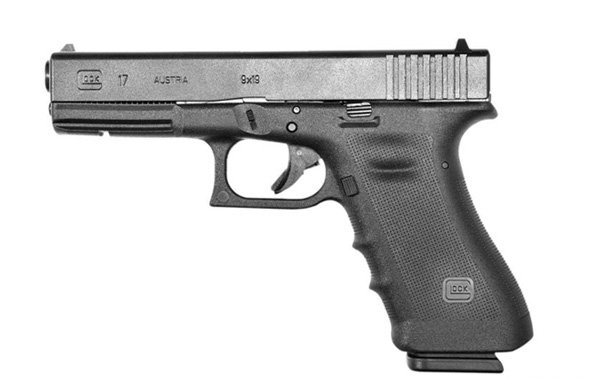Home | Top 4 Assault Rifles | Top 4 Sniper Rifles | Top 4 pistols
Pistol
| About Pistol | |
|---|---|
| Country of origin | Austria |
| Entered service | 1982 |
| Caliber | 9x19 mm Parabellum |
| Weight (unloaded) | 710 g |
| Weight (loaded) | 910 g |
| Length | 204 mm |
| Barrel length | 114 mm |
| Muzzle velocity | 360 m/s |
| Muzzle energy | 490 Joules |
| Magazine capacity | 17 rounds |
| Sighting range | 50 m |
| Range of effective fire | ~ 50 m |

In 1980 the Austrian army issued a requirement for a new pistol, that would replace the old Walther P-38. Various companies took part in this competition with their designs. These were Steyr GB, Heckler & Koch P7M13, SIG Sauer P220 and P225, Beretta 92S, and the previously unknown Glock 17. Eventually the Glock 17 was selected as a winner and was adopted by the Austrian Army in 1982. It was also adopted by Austrian Police. Full scale production commenced in 1986. In the following years this new and unusual pistol became one of the most popular handguns due to its advantages and aggressive marketing. It was adopted by numerous military and law enforcement forces from all around the world. Currently this pistol is in service with more than 50 countries. Some copies and clones of this pistol appeared. One of them is a Smith & Wesson Sigma. The Glock 17 was a clean sheet design. It is not a variation of any previous design. This pistol was developed by a Glock company, headed by Gaston Glock. The Glock 17 proved to be highly successful. At the time of its introduction this pistol was referred as a revolutionary design. Even though it incorporated previously known solutions. This pistol is simple, reliable, lightweight and inexpensive. This pistol has a simple design with a minimum of parts. There are only 33 parts, including the magazine. This pistol can be disassembled within a minute using just a pin, or nail. Many of the parts are interchangeable between various Glock models. The Glock 17 is simple in operation and failures are rear. Low weight was achieved by making most of the parts, including the frame out of polymer. The only metal parts are barrel, slide and trigger mechanism. Even though this pistol is made of polymer, it operates well within a temperature range from -40°C to +200°C. Also this rugged pistol do not rusts. All metal parts are covered with rustproof coating. The Glock 17 literally revolutionized the firearms market. Today virtually all major handgun manufacturers offer polymer-framed pistols. When these polymer frame pistols began to receive widespread public attention in the 1980s, they became a media sensation around the world. But not because of the weight savings ad ergonomical improvements that composite materials allowed for. Instead, widespread hysteria broke-out over the supposed ability of these pistols allowing anyone of smuggle them through metal detectors and x-ray machines, because they were "made of plastic". It was either overlooked or ignored that the Glock 17 has 83% steel, giving it a larger metallic mass than a pocket pistol. It was also somehow forgotten that x-ray machines had no difficulty detecting non-metallic objects. The Glock 17 has high muzzle energy and provides good penetration, even with 9x19 mm ammunition. It is claimed that barrels of the Glock pistols have a service life of approximately 360 000 shots. It is a really impressive figure, as barrels of other modern and high quality pistols last only about 40 000 shots. This semi-automatic pistol is fed from a 17-round double-stack magazine. The magazine is also made of polymer. Extended capacity magazines that hold 19 or 33 rounds are also available. Compact and sub-compact models come with smaller magazines. In some cases magazines are interchangeable between various models. This pistol has no manual safeties. Instead it uses a patented "safe action" trigger system. An automatic safety is built into the trigger. It blocks the trigger if it is not pulled properly. It eliminates self-action or accidental shots. After each shot the safety lock is reset and turned "on", until the trigger is pushed once more. Another automatic safety does nor permit fire if the barrel is not fully locked. Most of the Glock family pistols have fixed sights. Only special target models, intended for competitions, have adjustable sights. Since its introductions the Glock 17 undergone a number of revisions. The first generation pistols were produced between 1986 and 1990 and were chambered for 9x19 mm ammunition. The second generation pistols were produced between 1990 and 1998. These had slightly different frames with textured grips. The second generation introduced new calibers, including 9x22 mm (.375 SIG), 10x22 mm (.40S&W), 10x25 mm (10 mm Auto) and 11.43x23 mm (.45 ACP). The third generation pistols were produced between 1998 and 2010. These pistols were fitted with accessory rail below the barrel, and had some other improvements. Production of the forth generation pistols started in 2010. These have a larger magazine release button, replaceable back straps for better ergonomics, and some minor internal improvements. After initial success the basic Glock 17, the Glock company developed a large number of models, based on the same basic design. These are chambered in all major pistol calibers. Various models also have different dimensions, barrel length, and magazine capacity. Pistols are available in standard, compact, subcompact, target and other models.